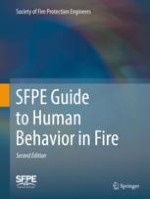2019 | OriginalPaper | Buchkapitel
3. Population Characteristics
verfasst von : Society of Fire Protection Engineers
Erschienen in: SFPE Guide to Human Behavior in Fire
Aktivieren Sie unsere intelligente Suche, um passende Fachinhalte oder Patente zu finden.
Wählen Sie Textabschnitte aus um mit Künstlicher Intelligenz passenden Patente zu finden. powered by
Markieren Sie Textabschnitte, um KI-gestützt weitere passende Inhalte zu finden. powered by
